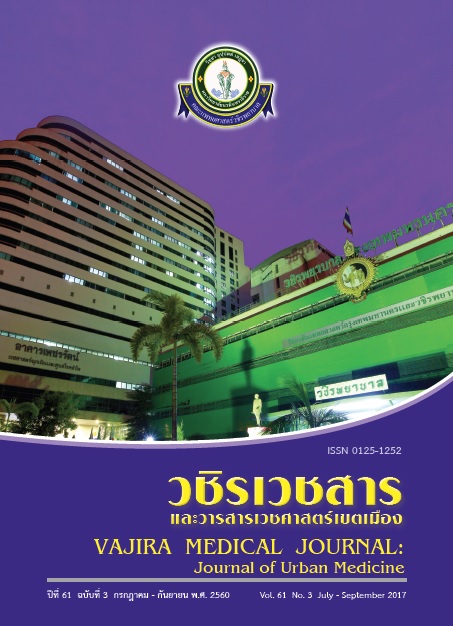Clinical Use of Otic Solution Ear Drop
Main Article Content
Abstract
Ear drops contain drugs and a solvent. Ear drops include five categories: 1) Cerumenolytic: earwax softener to help soften earwax and make it slips out easily with the use of water and a detergent. 2) Anti-bacterial agents: common pathogenic bacteria are Pseudomonas aeruginosa and Staphylococci. Ciprofloxacin has been recognized as standard non-ototoxic therapy for infections in the middle and inner ear. 3) Anti-fungal agents: the most common fungal pathogens are Aspergillus nigra and Aspergillus fumigatus. Commonly-used anti-fungal include clotrimazole, acetic acid, gentian violet and boric acid. 4) Corticosteroid: the drugs is commonly used to reduce pain and swelling. 5.) Anesthetic: Knowing how to administer medication and the common complications that may occur is important for the safety of patients.
Article Details
References
2. Mj B, Doree C, Burton MJ, Doree C. Ear drops for the removal of ear wax. Cochrane Database Syst Rev. 2009;(1):1–3.
3. Roland PS, Smith TL, Schwartz SR, Rosenfeld RM, Ballachanda B, Earll JM, et al. Clinical practice guideline: Cerumen Impaction. Otolaryngol Head Neck Surg. 2008;139 (3 Suppl 2):S1-21.
4. Kim JK, Cho JH. Change of external auditory canal pH in acute otitis externa. Ann Otol Rhinol Laryngol. 2009;118(11): 769–72.
5. Rosenfeld RM, Schwartz SR, Cannon CR, Roland PS, Simon GR, Kumar KA, et al. Clinical practice guideline: acute otitis externa. Otolaryngol Head Neck Surg. 2014;150(1 Suppl):S1–24.
6. Tsilis NS, Vlastarakos P V, Chalkiadakis VF, Kotzampasakis DS, Nikolopoulos TP. Chronic otitis media in children: an evidence-based guide for diagnosis and management. Clin Pediatr (Phila). 2013;52(9):795–802.
7. Dohar J, Kenna M, Wadowsky R. In vitro susceptibility of aural isolates of Pseudomonas aeruginosa to commonly used ototopical antibiotics. Am J Otolaryngol. 1996;17:207–9.
8. Brummett RE, Harris RF, Lindgren JA. Detection of ototoxicity from drugs applied topically to the middle ear space. Laryngoscope. 1976;86:1177-87.
9. Greg M, Leonard R, Ototoxicity of ototopical antibiotic drops in humans. Otolaryngol Head Neck Surg. 2004;130: S79-82.
10. Kaplan DM, Hehar SS, Bance ML, Rutka JA. Intentional ablation of vestibular function using commercially available topical gentamicin-betamethasone eardrops in patients with Meniere’s disease: further evidence for topical eardrop ototoxicity. Laryngoscope. 2002;112: 689-95.
11. Wright C, Meyerhoff W. Ototoxicity of otic drops applied to the middle ear in the chinchilla. Am J Otolaryngol. 1984;5: 166–76.
12. Munguia R, Daniel SJ. Ototopical antifungal and otomycosis: A review. Int J Pediatr Otorhinolaryngol. 2008;72: 453-9.
13. Fairbanks DNF. Pocket guide to antimicrobial therapy in otolaryngology – head and neck surgery, 13th Ed. Alexandria, VA: American Academy of Otolaryngology Head and Neck Surgery Foundation; 2005. p 55-7.
14. Thailand National List of Essential Medicines (NLEM) 2016. 2nd Revision. Nonthaburi: Ministry of Public Health; 2016. p 84-6.
15. Phillips JS, Yung MW, Burton MJ, Swan IRC. Evidence review and ENT-UK consensus report for the use of aminoglycoside-containing ear drops in the presence of an open middle ear. Clin Otolaryngol. 2007;32(5): 330–6.

